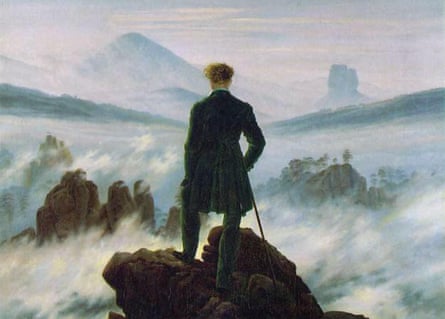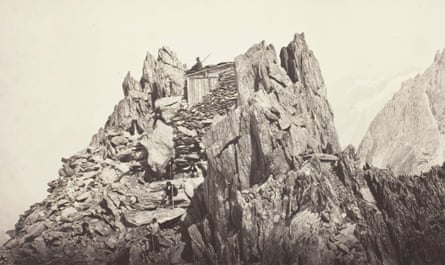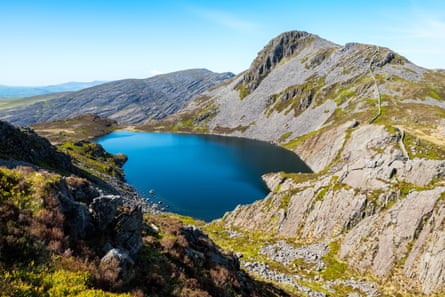After a tough scramble to the summit of Rhinog Fach, we look down into the deep valley holding the chilly waters of Llyn Hywel, then west across several miles of heather, bilberry and bare rock to the Welsh coast. Turning my gaze north, there is the entire Llyn peninsula leading east to the peak of Yr Wyddfa (Snowdon), no doubt weighed down by thousands of visitors. Up here there are just two of us in an utterly peaceful landscape. No clouds on the horizon. No surprises.
I lie down for a few minutes and feel myself drift off. There are no human voices to be heard, only birds. Summer has come early to these mountains and I wouldn’t be anywhere else, drinking in that particular kind of tranquillity to be found on a peak under a blue sky.
Mountains were not always seen as appropriate places to relax on a summer’s day. Those lofty, mist-wreathed realms held surprises, most of them nasty, such as trolls and demons. Maybe a few ancient folk knew perfectly well that mountains in summer were wonderful, but they weren’t the sort to publicise the fact: the solitary shepherd, gold prospectors not yet consumed by gold fever, and the workers who put up drystone walls – they all must have known the joy of lazing on a summit, perhaps seeing shapes in clouds.
Changing culture and taste took a revolution led by artists and poets, men such as Nicolas Poussin, who in the 17th century tried to win people over with paintings of mysterious peaks and epic landscapes. Unfortunately, he couldn’t resist adding a fallen Grecian column and a nymph draped in wispy stuff. It took another 150 years before the German artist Caspar David Friedrich relocated the wispy bits to the mountain tops, evicted the nymphs, and added one rugged poetic type, gazing out over the towering tors with a vaguely proprietorial air. His Wanderer Above the Sea of Fog (1818, now in Hamburg at the Kunsthalle) remains the most evocative depiction of the romantic ideal.

After that painting, summer in the mountains was de rigueur, but it turned out that Friedrich’s sturdy 19th-century mountaineer was actually looking for a place to build a man-shed. All over the continent, wealthy romantics started funding simple dormitory accommodation, often precariously balanced on vertiginous crags. These mountain refuges were vital in allowing people to access the peaks, and became a huge part of my own enjoyment of the mountains.
The first to be built was Refuge des Grands Mulets on Mont Blanc in 1853. There is still a hut there, rebuilt a couple of times, perched at 3,051 metres (10,009ft), overlooking the Bossons glacier. My own favourite, Rifugio Nuvolau, is a period classic in the Dolomites, built in 1883 and a haven of stout carpentry, hearty food and astonishing sunsets. Not all are antiques: Monte Rosa near Zermatt is an aluminium solar-powered box that sits above the Gorner glacier and requires ropes and crampons in order to reach it.
Some huts are very high indeed: the Margherita on the Italian Monte Rosa is, at 4,554 metres, the highest building in Europe. Sweden’s Låktatjåkko (1,228 metres) is both high in altitude and latitude: it’s 155 miles (250km) inside the Arctic Circle and often buried in snow, even in summer. Digging to the front door is worth the effort: they serve fantastic waffles with cloudberry jam.
The staff in these huts are usually charming and helpful. Not all guests, however, are so wonderful. “There was one British visitor who, during the course of the night, pushed all the other sleepers along the dormitory bench,” complained one French guest after staying in Refuge de Ciottulu di i Mori in Corsica. “He left a huge empty space behind him and we were all squashed up in one corner.” (I’ve no idea why I rolled like that. I was fast asleep.)

Making a reservation in one of these treasures can require persistence. The famous ones are often booked out, but many of the huts I’ve mentioned have alternatives nearby.
Where there are no mountain huts available, a tent is not always needed. In Romania’s Carpathians, I’ve slept in hay ricks after jolly evenings drinking plum brandy with farmers. Sadly, the hay rick is disappearing as agriculture modernises, but the Carpathians remain a fine mountain destination.
Once a local hunter persuaded me to go on a bear hunt (no guns involved). We climbed through shady pine forest and golden flower-sprinkled meadows to warm rock and vast vistas. The hunter described a recent incident when he was chased up a tree by a bear. He proved it by showing his rucksack, complete with claw marks. On our descent, we stumbled on a fresh bear track and, for a second, the idyllic evening was shot through by lightning bolts of adrenaline.
An undeniable fact of mountain life is that moments of arcadian bliss can be abruptly ended. You go up in sun, and descend in a wild storm. The unpredictable must be expected. Helm Crag in the Lake District was a favourite of Romantic poet William Wordsworth and for that reason many go to commune with nature.
One blustery lunchtime, I was sitting a little below the craggy summit about to enjoy a picnic when a group on the top suddenly flung their grandmother into the air. Caught by the wind, the old lady was whipped sideways and down, straight into the sandwich that was about to go in my mouth. Ash-scattering ceremonies really should be more careful. The ancestor went to her final resting place tainted with Branston pickle.
after newsletter promotion
British mountains aren’t enlivened by European-style huts, but we do have bothies, camping barns, the Youth Hostels Association (YHA), and a number of good cottages for hire. To climb the Rhinogydd (often anglicised to Rhinogs), I based myself at the off-grid retreat of Garth Gell farm, all lovely hand-worn woodwork, flagstone floors and dusty books.
The Rhinogydd are often touted as the most rugged mountain chain south of Hadrian’s Wall, which is a bit hard on the North Pennines and Cheviots, but the paths are certainly steep and challenging, deterring many visitors. The chain stretches for about 13 miles, with the highest point at Y Llethr (756 metres) where the 360-degree panorama is really special. The view is, of course, a big part of the attraction. We go up because we can see further.

My snooze on Rhinog Fach is interrupted by my companion. “Look!” he says. The best summer mountain experiences always have that unexpected moment: the bear jumps out and claws your rucksack, human remains land in your picnic … that kind of thing. I sit up, suddenly alert.
“On the wall. Down there.”
There’s a bird, its pale chest striped with grey, its tail fanned out in annoyance as a horde of smaller birds are mobbing it. And then it calls.
I have never considered the cuckoo to be a mountain bird, but there it is at 600 metres on a Welsh hill. And at the same time, away to the west, the haze lifts a little and the blue horizon puckers behind the last bit of Wales. The Blackstairs Mountains of Ireland have appeared. A summer’s day in the mountains is complete.
Accommodation was provided by Garth Gell, a Kip hideaway, which sleeps six from £240 a night

 3 months ago
65
3 months ago
65

















































